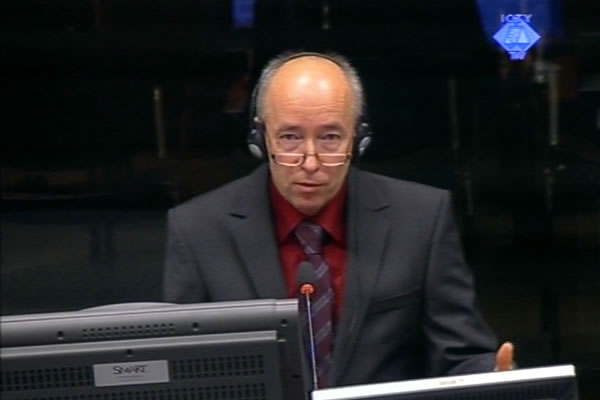Home
PRISON CAMP FOR ETHNIC CLEANSING
Describing the conditions in the Trnopolje prison camp, Idriz Merdzanic, a medical doctor from Prijedor, said that most of the prisoners were women, children and elderly. After a brief detention, they were moved out of the Serb territory in ‘cattle wagons and buses’. The witness explained why there were detainees on both sides of the barbed wire fence in the prison camp when the foreign journalists visited Trnopolje
 Idriz Merdzanic, witness at the Ratko Mladic trial
Idriz Merdzanic, witness at the Ratko Mladic trial In his evidence at the trial of Ratko Mladic, Dr Idriz Merdzanic from Prijedor said that the purpose of the Trnopolje prison camp was to achieve ‘ethnic cleansing’. Civilians – mostly women, children and elderly – were brought there after they had been expelled from their houses. Then, they were evacuated by rail, in cattle wagons, and in trucks from Prijedor municipality, which the Serbs claimed as their territory, Merdzanic recounted.
Dr. Merdzanic was one of the few men of military age detained in Trnopolje. During his stay there, he worked in the prison infirmary, caring for the Muslim and Croat civilians, beaten and exhausted. Merdzanic arrived in the prison camp in May 1992 after the Serb forces entered Kozarac where he had been working in the local health clinic. Kozarac was first heavily shelled. On 26 May 1992, the inhabitants were arrested and taken to the Prijedor prison camps. Women and children were mostly taken to Trnopolje while men of military age were taken to Omarska and Keraterm. Their houses were looted and burned down, as were the mosques and Catholic churches. The objective was to prevent the villagers from returning, because they would ‘not have anything to return to’, Merdzanic explained. Other villages in the Prijedor area suffered a similar fate. As time went by, the number of detainees in the three prison camps increased.
The statement the witness gave to OTP in August 2000 was admitted into evidence today. In the statement, the witness said that conditions in Trnopolje were ‘inhumane’ and that detainees were beaten, raped and killed. According to the witness, the prison camp commander, Major Slobodan Kuruzovic, and his assistant Slavko Puhalic knew about the violence against prisoners. Merdzanic recalled that both Kuruzovic and Puhalic wore camouflage uniforms while prison guards had regular olive drab military uniforms.
The number of men in Trnopolje increased suddenly just before 4 August 1992, when a group of foreign journalists visited the prison camps in the Prijedor area on Radovan Karadzic’s approval. Merdzanic explained that some of the prisoners had been transferred from Omarska to Manjaca and some had been moved to Trnopolje. Beds and food were issued to the prisoners to make the conditions appear better than they actually were during the journalists’ visit. At the same time, the Keraterm prison camp was almost completely evacuated. Some of the prisoners were sent to Trnopolje. There, they were separated from the other detainees by a barbed wire fence. The cameras of the British TV crew led by Penny Marshal captured those prisoners, the witness explained, and that was why the footage shows the detainees on both sides of the wire fence.
Mladic’s defense counsel wondered why a wire fence would be put up inside the prison camp before the journalists visited and removed after they left. The witness explained that a visit to Trnopolje had not been planned, but the journalists demanded to go there on their way back from Omarska. After the world public saw the broadcasts of Penny Marshall’s footage and the photos of badly beaten prisoners, given to her clandestinely by the witness, the wire was removed and the newcomers from Keraterm were able to mix with the other detainees. As Merdzanic said, they told him that about 200 men had been killed in a hangar in Keraterm before their transfer to Trnopolje. The people from Omarska spoke about torture and murder in the building called ‘the white house’.
The defense counsel tried to challenge the existence of a link between the prison camp management and guards on the one hand and the army headed by the accused Mladic. The witness repeated that the prison camp commanders and guards wore military uniforms, but could not elaborate. Asked if any of the guards tried to help the prisoners, the witness replied he ‘never claimed that all Serbs were bad’. Some of the guards did indeed help him and the prisoners, as did Serb civilians.
Doctor Merdzanic was released from the prison camp on 30 September 2012. Now he recalls the war events only when he comes to The Hague to give evidence. Once home, ‘I close that book and don’t think about it anymore’, the witness said.
Linked Reports
- Case : Mladic
- 2012-09-28 ‘VOLUNTARY' EXPULSION FROM PALE
- 2012-09-28 NEW RULES FOR MLADIC
- 2012-09-27 SELAK TAKES PRIDE IN ORDERS HE DIDN’T OBEY
- 2012-10-02 RATKO MLADIC'S FIRST VICTIMS IN SARAJEVO
- 2012-10-02 ETHNIC CLEANSING WAS BASED ON THE 'PROPERTY MAP' OF PRIJEDOR
- 2012-10-03 MLADIC’S DEFENSE SAYS ARMY HAD NOTHING TO DO WITH CRIMES IN OMARSKA
